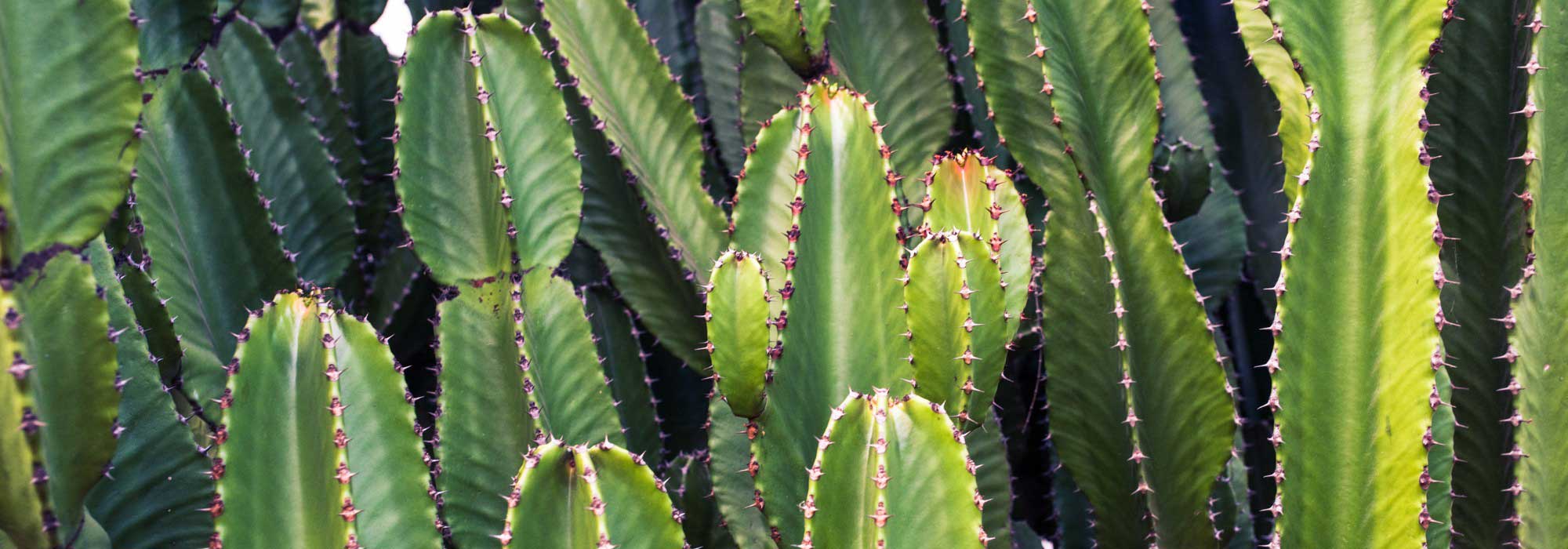
Euphorbia cactus : planting, growing and caring
Contents
Cactus Spurge in a nutshell
- Cactus euphorbias are succulent plants that closely resemble cacti!
- They often form thick, upright, and ramified stems, equipped with thorns.
- Native to Africa, they thrive in warm and dry climates.
- They have a very graphic style and easily add an exotic touch to a flat or house.
- They require plenty of light and should be placed near a well-exposed window.
- They need little watering and are sensitive to excess moisture.
The word from our expert
The Cactus Spurges, often mistaken for true cacti, are succulent plants belonging to the genus Euphorbia. Native to arid regions of Africa, they are prized for their striking and exotic appearance. With their thick, thorny stems, they closely resemble cacti but are distinguished by their botanical characteristics. Moreover, they are cultivated almost like cacti: they require a very bright exposure, well-draining soil, are drought-resistant, and dislike excess moisture. Once potted, they require minimal maintenance and are easy to grow.
There are many species of succulent spurges, differing mainly in size and silhouette: we invite you to explore the full diversity of cactus spurges! They can easily be showcased in a bright living room or office, paired, for example, with cacti in a mineral and exotic setting. Discover all our tips for successful cultivation, from potting to care and propagation by cuttings!
Description and Botany
Botanical data
- Latin name Euphorbia sp.
- Family Euphorbiaceae
- Common name Cactus euphorbia, succulent euphorbia
- Flowering Rare indoors
- Height Varies by species, but can reach up to 2 m
- Exposure Bright, indirect light
- Soil type Very well-draining, sandy or rocky
- Hardiness Frost-sensitive (5 to 10 °C depending on the species)
Although they resemble true cacti (thick stems, thorns, striking silhouette), succulent euphorbias are not cacti at all, as they do not belong to the Cactaceae family but to the Euphorbiaceae family.
The Cactus euphorbia belongs to the genus Euphorbia, which includes over 2,000 species, some of which are succulent and others not. Some euphorbias even grow wild in France, such as Euphorbia amygdaloides, Euphorbia characias, Euphorbia cyparissias, or Euphorbia lathyris. These species are not succulent and bear no resemblance to cacti. As for cactus euphorbias, they are primarily native to Africa, Madagascar, and certain arid regions of Asia. They have evolved to survive in dry, rocky environments where water is scarce and temperatures are high.
These euphorbias resemble cacti simply due to convergent evolution, an adaptation to extreme climatic conditions: their thick stems allow them to store water and minerals, while their leaves have either disappeared or been reduced to thorns to limit evapotranspiration (plants lose water through their foliage), enabling them to conserve water and survive.
Living in particularly arid climatic conditions, subject to the same constraints as cacti, these euphorbias have adopted the same survival strategy, which is why they look so similar. This is the same reason for the resemblance between Aloes and Agaves, which also do not belong to the same botanical family (Asphodelaceae and Asparagaceae).
The Cactus euphorbia is a tropical and subtropical plant that does not tolerate intense cold. Most species cannot withstand temperatures below 10 °C and must be grown in pots in regions with harsh winters. Outdoors, they thrive in warm, dry climates where temperatures range between 15 and 30 °C. Indoors, they adapt well to typical household temperatures, provided they receive ample sunlight.
Cactus euphorbias encompass many different species. Among the most commonly cultivated are:
- Euphorbia trigona: Recognisable by its tall, upright stems, typically with three ribs, adorned with small thorns and spatulate leaves. There is a variety with red to purple stems: Euphorbia trigona f. Rubra.
- Euphorbia erythrea: Forms tall, upright, quadrangular stems with thorns along the ribs. Its highly exotic silhouette resembles candelabra cacti.
- Euphorbia acrurensis : This euphorbia features an elegant silhouette with thick, ribbed, and more or less branched stems.
- Euphorbia canariensis : Native to the Canary Islands, this species grows into large clumps of quadrangular columnar stems covered in small thorns. It closely resembles columnar cacti and can reach several metres in height in its natural habitat.
- Euphorbia lactea: This species stands out for its stems marbled with green and white. It is often grafted onto other euphorbias to create unique shapes. A particularly sought-after variety is the Euphorbia lactea ‘Cristata’, whose fan-shaped growth creates a sculptural effect.
- Euphorbia resinifera: Native to Morocco, this species forms compact clumps of bluish quadrangular stems. It is highly drought-resistant and adapts well to rock gardens. Unlike other columnar euphorbias, it remains relatively short, rarely exceeding 1 metre in height.
- Euphorbia horrida: Often mistaken for a cactus, this South African species features spiny, ribbed stems in a blue-green hue. It is prized for its exotic appearance and ease of care in pots. Some varieties have reddish-brown thorns that add an extra decorative touch.
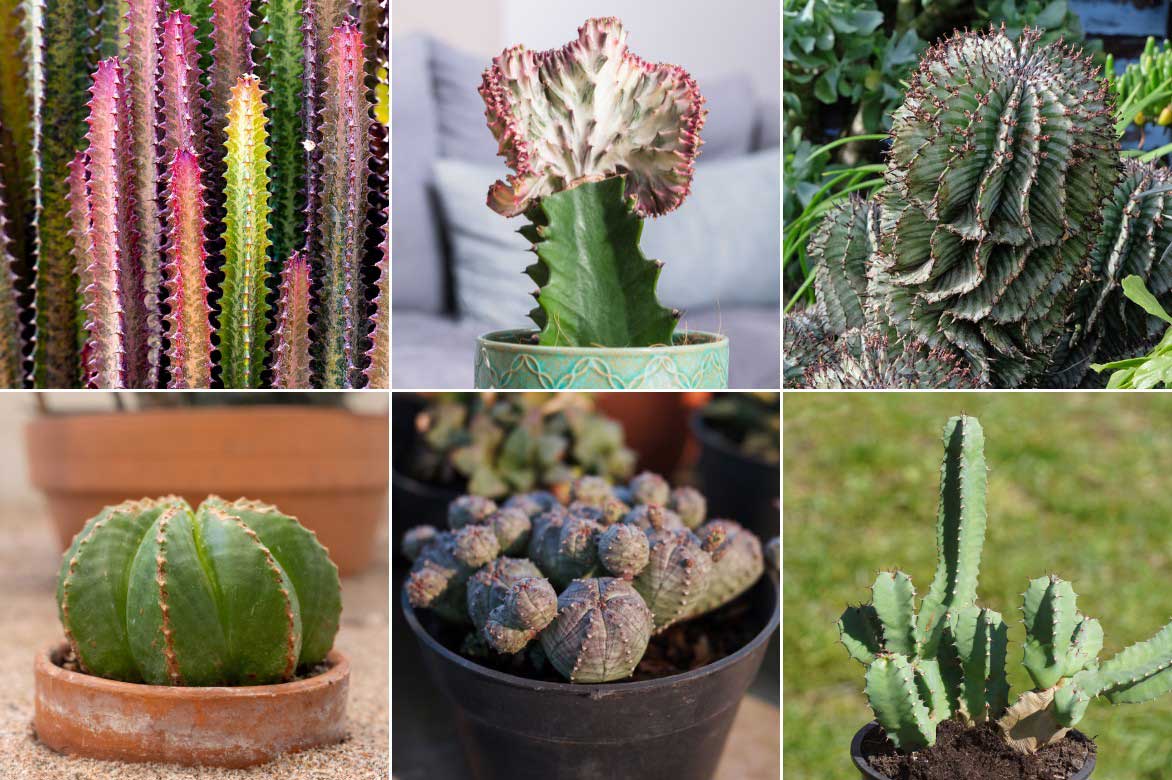
Succulent euphorbias can take on very diverse forms! Euphorbia trigona ‘Rubra’, Euphorbia lactea ‘Cristata’, Euphorbia horrida, Euphorbia meloformis, Euphorbia globosa and Euphorbia resinifera
The Cactus euphorbia is distinguished by its upright habit and silhouette reminiscent of columnar cacti. Its fleshy, often ribbed stems covered in thorns allow it to store water to survive long periods of drought.
Dimensions vary considerably depending on the species. Some varieties, like the Euphorbia trigona, can reach up to 2 metres when grown indoors in pots. Others, such as Euphorbia lactea, rarely exceed 1.5 metres in height and grow more slowly. There are also creeping or bushy forms, ideal for pot cultivation or rock gardens.
Although Cactus euphorbias are primarily grown for their foliage and architectural form, they occasionally produce inconspicuous flowers. Unlike cacti, their flowers are not spectacular: they are generally small, yellow, green, or red, and appear at the axils of the stems. In some species, flowering may be rare indoors or require specific growing conditions, such as water stress or intense sunlight.
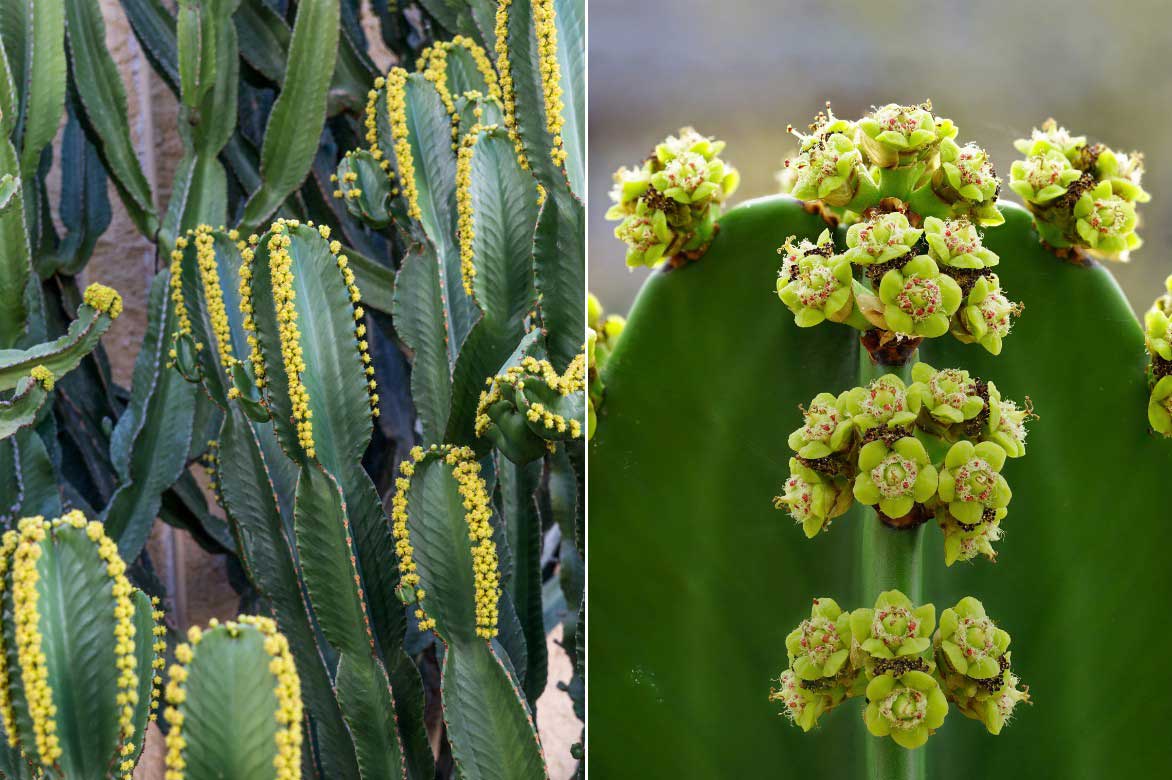
Left, Euphorbia canariensis in flower; right, detail of the flowers of Euphorbia ingens
The Cactus euphorbia does not have true evergreen leaves like other plants. In most species, leaves, if present, are small and quickly shed. Photosynthesis is carried out by the green, fleshy stems.
The stems often bear thorns, which are not true prickles like those of cacti, but modified structures derived from stipules. Some species, such as Euphorbia trigona or Euphorbia canariensis, have segmented stems with prominent ribs, while others, like Euphorbia lactea, display marbled patterns and more irregular shapes.
An important point to note is that all euphorbias, including those resembling cacti, contain a white, milky sap called latex, which is toxic. This sap can cause skin irritation, allergic reactions, and digestive issues if ingested. It is therefore essential to handle these plants with care, wearing gloves during pruning or repotting, and keeping them out of reach of children and pets.
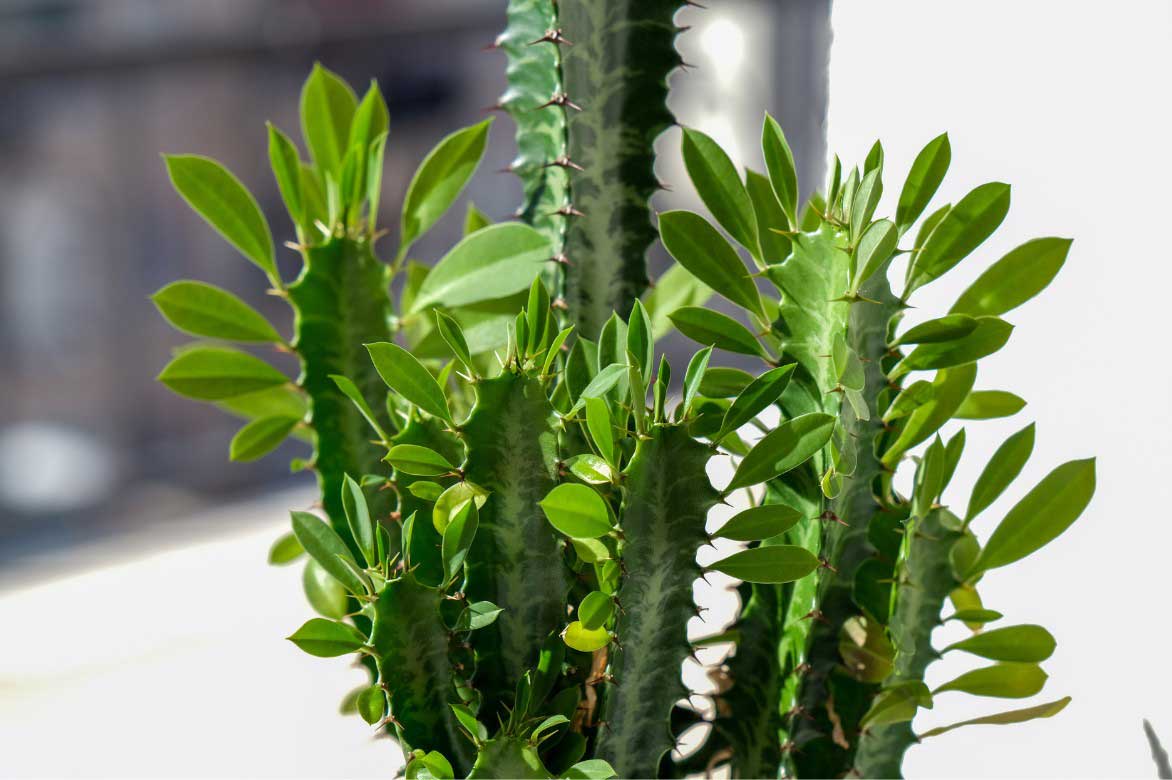
Euphorbia trigona
The most popular varieties
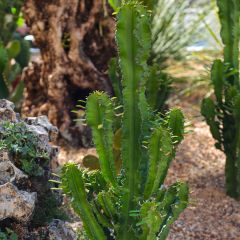
Euphorbia trigona - African milk tree
- Höhe bei Reife 1,60 m
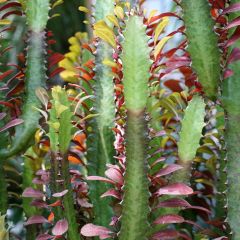
Euphorbia trigona f. rubra - African milk tree
- Höhe bei Reife 1,70 m
Planting the Cactus Spurge
Where to Place the Cactus Spurge?
The Cactus Spurge thrives very well in a pot, provided it is placed in a bright location. Ideally, it should receive at least 6 hours of intense indirect light or direct sunlight per day. The best spot is near a well-exposed window, facing south or west. A lack of light can lead to slowed growth, excessive stem elongation (etiolation), and a loss of its beautiful compact structure. If natural light is insufficient, especially in winter, using a horticultural lamp can be a good solution to compensate.
The Cactus Spurge prefers an ambient temperature between 15 and 30 °C. It dislikes cold drafts and temperatures below 10 °C. It is important to avoid placing it near poorly insulated windows in winter or too close to an air conditioner or radiator, which could dry it out or cause thermal stress.
Ambient humidity is generally not a problem, but if the air is too humid (such as in a bathroom), it is advisable to ensure good ventilation to prevent any mould from appearing on the substrate.
When to Plant the Cactus Spurge?
The best time to plant a Cactus Spurge is in spring or early summer, when temperatures are mild and the plant can gradually adapt to its new environment. Avoid planting in winter, as growth is slowed and the plant is more sensitive to excess moisture.
How to Plant It?
It is essential that the substrate is well-draining to avoid root rot. Use a special cactus compost or a mixture composed of compost, sand, and perlite in equal proportions.
- Choose a suitable pot: It should be pierced at the bottom to ensure good drainage. Preferably opt for a terracotta pot, which allows the roots to breathe and limits excess moisture.
- Prepare the substrate: Use a well-draining mixture, composed of cactus compost, coarse sand, and perlite.
- Plant the Cactus Spurge:
- Place a layer of gravel or clay pebbles at the bottom of the pot to promote water drainage.
- Position the plant in the centre and fill with the substrate, lightly pressing down.
- Leave a space of 1 to 2 cm below the rim of the pot to facilitate watering.
- After planting, wait a week before watering, to allow the roots to heal and reduce the risk of rot.
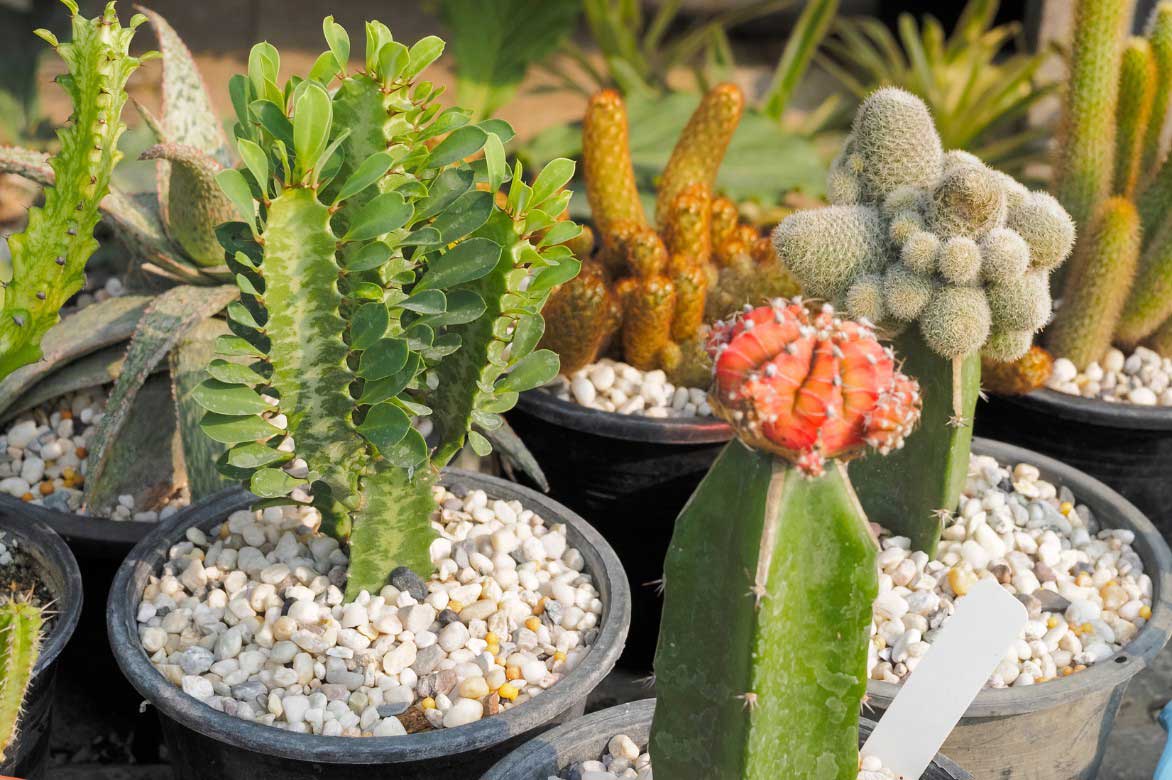
Plant the Cactus Spurge in a pot with a well-draining substrate, ideally cactus compost. You can optionally place gravel on the surface of the substrate for decorative purposes and to isolate the spurge from moisture.
How to care for the Cactus Spurge?
Watering: How and How Often to Water?
Watering is undoubtedly the most delicate aspect of caring for the Euphorbia cactus. Like all succulent plants, it is particularly sensitive to excess moisture, which can cause root rot.
During the growth period, from spring to late summer, watering every two to three weeks is more than sufficient. Always wait until the substrate is completely dry before watering again. In winter, when the plant enters dormancy, it is advisable to reduce watering even further, sometimes to once a month or even less.
A good indicator of water deficiency is the appearance of slight wrinkles on the stems. In this case, moderate watering will be enough to restore the plant’s vigour. Water should never stagnate at the bottom of the pot, which is why it is essential to use a container with drainage holes and to remove excess water after each watering.
Fertilisation: What Fertiliser for the Euphorbia Cactus?
Although the Euphorbia cactus can grow without fertilisation, a moderate application of fertiliser can promote more vigorous growth. A liquid fertiliser specially formulated for cacti, low in nitrogen but rich in potassium and phosphorus, can be added to the watering every four to six weeks during the growth period. However, it is unnecessary to apply it in autumn and winter, as the plant slows its metabolism and no longer requires additional nutrients. To avoid over-fertilisation, it is recommended to dilute the fertiliser in water and apply it to slightly moist substrate to prevent root burns.
How to Prune the Euphorbia Cactus?
Pruning the Euphorbia cactus is not essential, but it can be done to control its growth, stimulate branching, or remove damaged parts. Some species, such as Euphorbia trigona, can reach several metres in height when grown indoors. In this case, occasional pruning helps manage their development and prevents them from becoming too cumbersome.
Caution!: When cutting a stem, the plant secretes an irritating milky sap, so it is essential to wear gloves and protect your eyes. It is best to use a sharp and disinfected pruning shear to make clean cuts. After pruning, allow the wound to air-dry for a few days to prevent any risk of infection or rot.
When and How to Repot?
Like any potted plant, the Euphorbia cactus needs to be repotted every two to three years, depending on its growth. Repotting allows the substrate to be renewed and provides more space for the roots. It is advisable to do this in spring, when the plant is in its active growth phase. When repotting, it is essential to use a well-draining mix, composed of cactus-specific compost, coarse sand, and perlite. If the plant becomes too large and heavy to move, you can simply replace the top layer of the substrate every year to provide fresh nutrients.
Diseases and pests of the Cactus spurge
The Cactus Spurge is a robust plant and rarely prone to diseases when grown under good conditions. However, certain cultivation mistakes or parasitic attacks can affect its health. It is important to correctly identify problems and act quickly to prevent the plant from withering.
Diseases Linked to Excess Moisture
The main enemy of the Cactus Spurge is excess water, which encourages the development of fungal and bacterial diseases. Root rot is one of the most common issues. It manifests as a softening of the base of the stems, general yellowing, and sometimes an unpleasant odour. In advanced cases, the plant may turn black and collapse completely. When rot is detected at an early stage, it is possible to save the plant by repotting it in a dry, well-draining substrate after cutting away the affected parts. If the base is too damaged, it is better to attempt propagating healthy stems to obtain a new plant.
Excess moisture can also lead to the appearance of brown or black spots on the stems, often caused by fungi. These spots may remain superficial or gradually spread, weakening the plant. To avoid this issue, it is essential to maintain moderate watering and always wait for the substrate to dry completely before watering again. Good air circulation around the plant also helps limit the development of diseases.
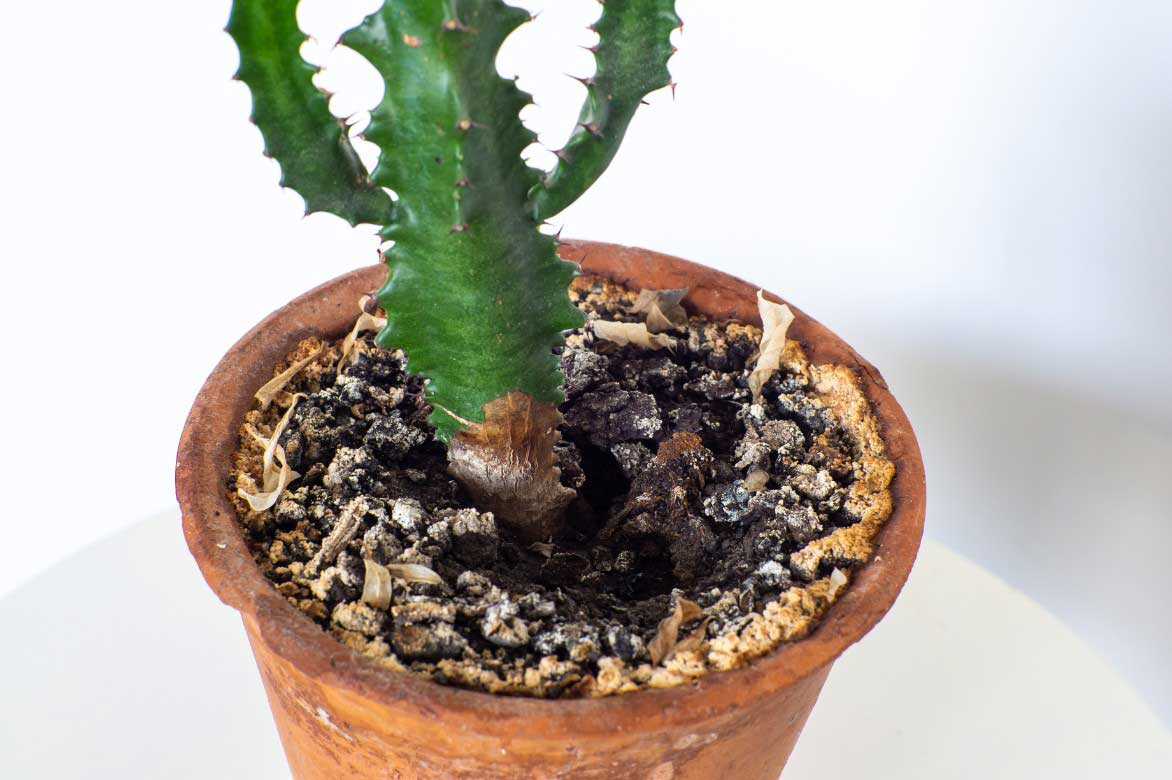
A Euphorbia lactea affected by fungi due to excess moisture. Note the mould on the surface of the soil and the necrotic collar of the plant. In this case, the best solution to save it is to propagate the stems.
Common Parasites
Although relatively resistant, the Cactus Spurge can be attacked by certain parasites, particularly mealybugs. These small insects appear as white, cottony masses or small brownish shields attached to the stems. They feed on the plant’s sap, which can lead to general weakening and slowed growth. To eliminate them, you can use a cotton pad soaked in 70% alcohol and gently rub the infested areas. A more natural solution involves spraying a mixture of water and black soap on the affected parts.
Spider mites can also attack the Cactus Spurge, especially in winter when the air is too dry. These tiny mites develop on the undersides of the stems and cause yellowing or a discoloured appearance. To prevent their appearance, it is recommended to maintain a slightly more humid atmosphere around the plant in winter by placing a small container of water nearby. In case of infestation, treatment with a natural miticide or a soapy water spray may be enough to eliminate them.
To learn more, check out our advice sheets on mealybugs and spider mites!
Injuries and Healing
Occasionally, the Cactus Spurge may show marks or scars from a cut, sunburn, or mechanical shock. Unlike diseases, these injuries generally do not endanger the plant, but they can leave permanent marks. To avoid unsightly marks, it is advisable to handle the plant gently and protect it from shocks. In case of accidental cutting, simply let the wound dry naturally, as the plant produces sap that forms a protective barrier.
Feel free to consult our advice sheet “How to Fail at Caring for Your Cacti and Succulents?”
How to propagate the Cactus Spurge?
The Cactus Spurge primarily propagates by cuttings, a simple and effective method to obtain new plants. Unlike cacti, which are commonly propagated by seeds, Euphorbias develop roots more easily from cut stems. However, this operation must be carried out with caution due to the toxic sap they release.
When and how to propagate the Cactus Spurge by cuttings?
Propagation by cuttings is ideally done in spring or summer, when the plant is in full growth. To do this:
- Choose a healthy stem, vigorous and 10 to 20 cm long.
- Cut it cleanly with disinfected pruning shears. Wear gloves and avoid any contact with the irritating sap.
- Stop the sap flow by briefly dipping the cut in cold water or letting it dry naturally.
- Let the cutting heal in the open air for several days to a week in a dry and shaded spot.
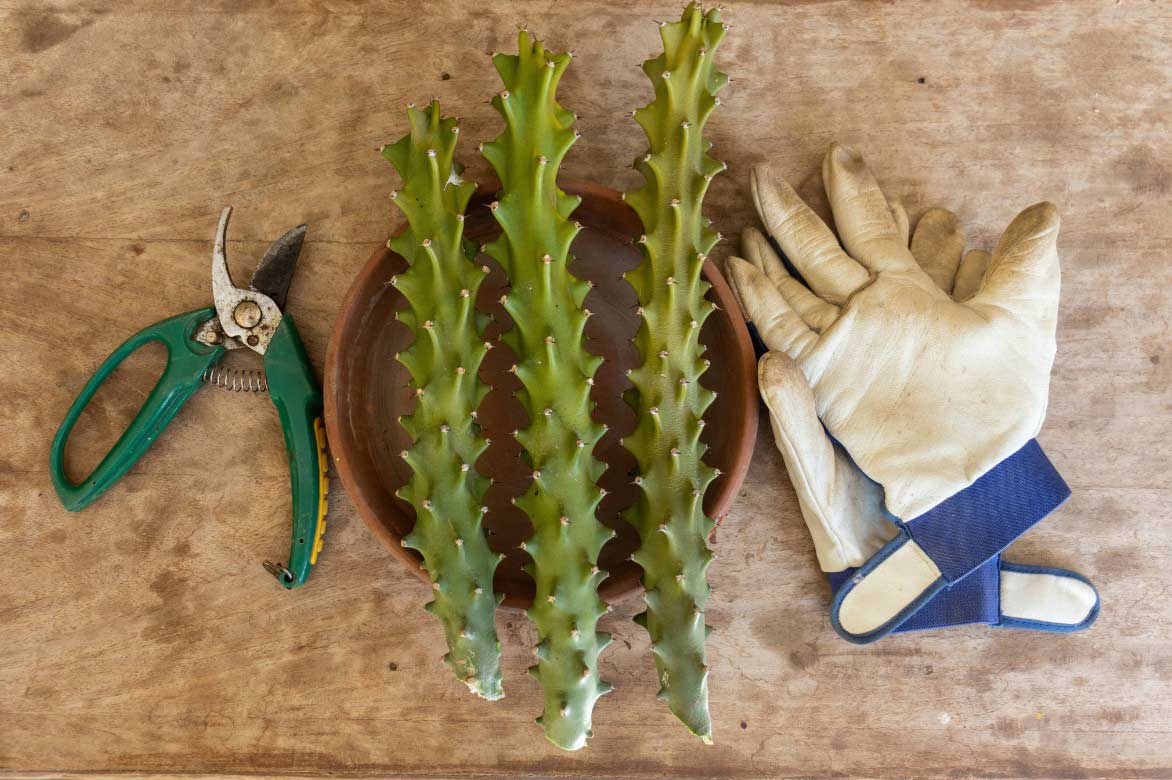
Cuttings of Euphorbia neriifolia. When propagating Euphorbias, ensure you wear gloves to protect yourself from the irritating sap and thorns, and let the stems dry in the open air before replanting them.
Planting and rooting
Once the cut is thoroughly dry:
- Plant the cutting in a well-draining substrate (special cactus compost, sand, and perlite).
- Do not water immediately: wait about a week before the first watering.
- Place it in a bright spot, without direct sunlight, which can be too intense.
Rooting takes a few weeks to two months. A gentle tug will help check if the plant is starting to anchor well.
What to do after rooting?
- Once well-rooted, the plant can be transferred to its final pot.
- Resume moderate watering, always allowing the substrate to dry out between waterings.
- Gradually acclimate it to its final location, especially if it will be exposed to more light.
For more information, check out our guide “Propagating Cacti and Succulents by Cuttings”

Euphorbia cuttings that have taken root and started growing again
How to showcase the Cactus Spurge and which plants to pair it with?
The Cactus Spurge fits perfectly into a modern and minimalist décor. Its slender and graphic habit makes it an ideal plant to pair with other succulents like Aloes, Agaves, or Haworthias, which share the same light and watering needs. Columnar cacti, such as the Cereus peruvianus, create a beautiful visual balance with it, while smaller plants with softer forms, like Gasterias, add contrast.
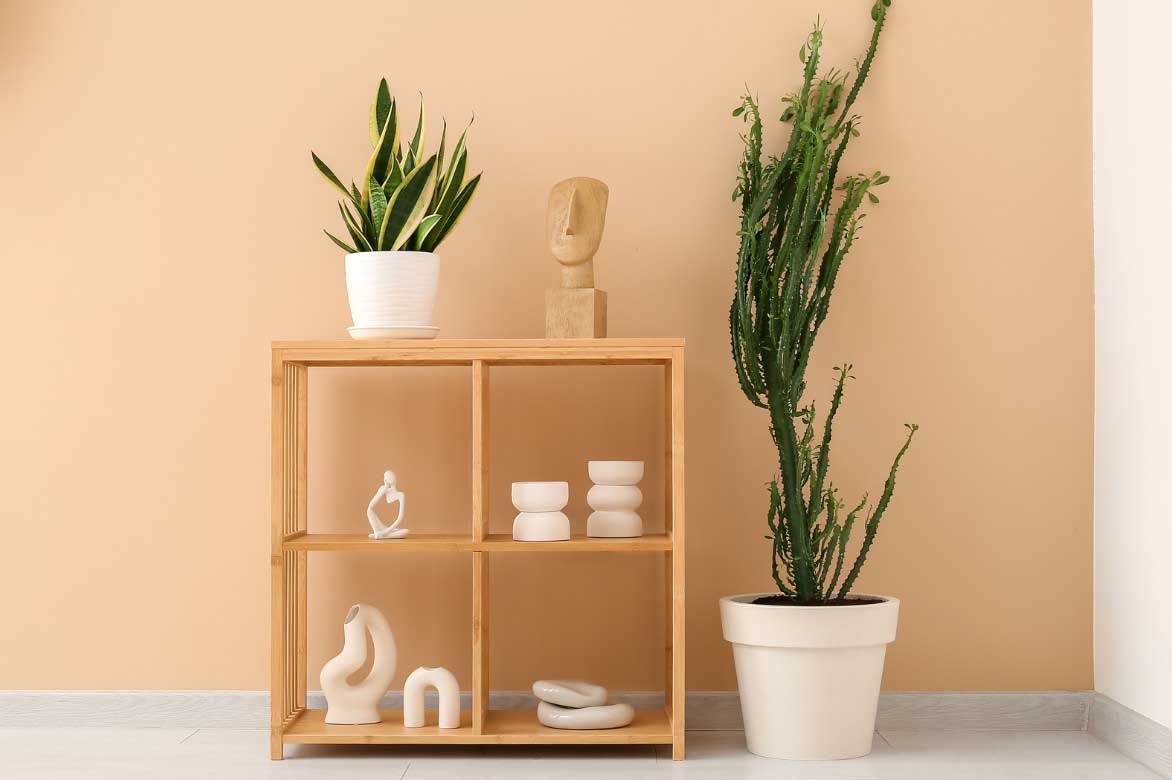
Euphorbia trigona and Sanseveria
In a mineral-themed setting, the Cactus Spurge can be highlighted with gravel, sand, or pebbles, recreating a desert-like atmosphere. A terracotta pot will enhance this natural and contemporary effect. Indoors, it can be placed near indirect lighting to accentuate its sculptural appearance and create interesting shadow play. The Spurge pairs wonderfully with warm-toned paint or furniture: yellow, orange, ochre, terracotta… which helps create an exotic and escapist ambiance. Moreover, these tones create a stunning colour contrast with the spurge, allowing it to stand out. For materials or décor, prioritise natural elements like wood or stone.

Euphorbia trigona and Dieffenbachia. The red brick wall and terracotta tones are perfect for highlighting the exotic silhouette of the spurge!
Euphorbia or Cactus: How to Tell Them Apart?
Succulent euphorbias and cacti are often confused, yet a few differences help distinguish them:
- The thorns of cacti are inserted on fuzzy areoles, whereas euphorbias lack areoles. The thorns of cacti can easily detach, unlike those of euphorbias, which are fused to the plant.
- If injured, euphorbias produce latex, a white, milky, toxic, and irritating sap.
- The flowers of cacti are large, often colourful, and equipped with numerous petals, while those of euphorbias are much smaller and more discreet, yet more numerous and rarely solitary.
Also worth reading
→ Discover our wide range of houseplants.
- Subscribe!
- Contents
































Comments